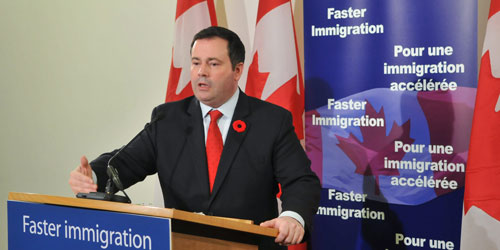
Canada’s immigration system will become fast, flexible and responsive to the labour market, with a proposed “just-in-time” application processing system coming into effect in 2013, promised Citizenship, Immigration and Multiculturalism Minister Jason Kenney this past fall. Kenney also said he expected to lift the pause in the federal skilled worker applications in 2013, when the new selection criteria would take effect. In advance of the New Year, Minister Kenney discussed Citizenship and Immigration Canada’s strategy on improving the immigration system with Canadian Immigrant.
Now that the pre-2008 backlog in immigration applications is erased, what does the new system hold?
The good thing about the new system is, we are just going to try keep things moving, and say, you take your chances and put in your expression of interest [to immigrate] and if you are offered a job or we think you have the right skills, we let you in, but don’t hold your breath.
But what about the people who are already here, who are either underemployed or struggling to find a job in their field?
We are not abandoning them; we want them to succeed, too. We’ve been supporting various internship and mentorship programs for immigrant professionals to help coach them to find jobs, to develop a network and to understand the Canadian work environment.
Second, we have a $50 million investment in the Pan-Canadian Framework for the Assessment and Recognition of Foreign Credentials, where we are working with provinces and their professional regulatory bodies to speed up and streamline the process for credential recognition.
We’ve also introduced, through Human Resources and Skills Development Canada (HRSDC), funding for a pilot project to provide micro-credit loans to foreign-trained professionals who need to pay for classes or for certification exam fees.
Many foreign-trained professionals working in survival jobs need to take additional courses to maybe get their certification. But they are working in a survival job to feed their family, they’ve depleted their savings … they are in a box. So all they need often is a little bit of financing to take a few additional courses, to get a diploma or pay for their certification exam fees. So we are now working with banks to provide up to $10,000 to these foreign-trained professionals so they can now upgrade their skills.
The micro-credit loan pilot project is administered by non-profits that link up with financial institutions and what we are paying for it is all the administrative costs that help the non-profit organizations to match foreign-trained professionals with financial institutions.
Are there any incentives for employers to hire them? It seems like the incentive for them now is to go find new people abroad.
So many immigrants say to me, “Why are you bringing in so many more new immigrants? We came here five or 10 years ago and we are struggling find jobs, I’m struggling, my kids are struggling …” I call that the pull up the ladder syndrome… I sympathize with that view … that’s why we oppose much higher levels of immigration.
The NDP wants us to increase the numbers by at least 100,000. Lots of employers want us to do the same thing, because they keep facing labour shortages; the western provinces are asking for higher levels. I’ve got all of these people clamoring for more, and then I meet immigrants who are saying there are already too many people competing for scarce jobs. All I can say is there is no perfect answer. We are trying to strike a balance.
In the long run, we need new people who are young and dynamic, who can replace people who are retiring from the workforce. We need these younger people from abroad to pay the taxes so we can take care of our retiring baby boomers — it’s a big demographic piece … that’s why we are maintaining high levels.
But, on the other hand, I am looking at this side and I’m seeing 7.4 per cent unemployment, 14 per cent youth unemployment and 14 per cent unemployment among immigrants … I have to calibrate this very carefully.
Some of these new immigrants we’re talking about are international students who are transitioning to permanent residency. You mentioned 72,000 study permits have been granted in the last year. How many of those are for students in full-time studies who can go to the next level in eligibility for permanent residency?
I don’t know. But it’s surprising that the number of foreign student graduates applying for permanent residency through the Canadian experience class is a tiny fraction of the number of foreign students in Canada.
The program disappointed us in terms of the enrolment at first. The very first year when we opened this stream in 2009, we hoped to get 8,000 qualified applicants — we only had 2,000, but it’s growing steadily since then and in 2013 we expect it to be admitting 10,000. It is gaining momentum … I think one of the reasons is these students who may have decided to stay, went through provincial nominee programs … Ontario has a PhD stream, other provinces allow foreign students to become permanent residents, and, many of them want to go back [to their countries of origin].
We hope that it will continue to grow. I think these are ideal immigrants in terms of their youth, their Canadian education, they’ve already developed soft social skills, they’ve perfected their English, and they have to work in Canada before we give them their PR in Canada, so they have demonstrated that they can get good jobs here. I’m just very, very optimistic about their prospects.
Which countries are we looking at for immigrants through the CEC?
That will be in proportion to the countries from which most students come from. And that right now tends to be India and China.
Do you think that might change, with economies of these countries growing, offering better employment prospects to their citizens?
These things fluctuate based on many factors. The reason we have had very little from Europe in the past 20 years is because, until very recently, the European economy has been very strong. There is a misunderstanding out there — people think the federal government arbitrarily assigns quotas for admissions to immigrants from various countries … one year we choose China, one year we choose India … it doesn’t work like that. It’s just based on demand, and the demand fluctuates for all sorts of different reasons, but I anticipate that Asia will continue overall to be the number one source region just because of the sheer numbers over there. And, right now, China, India and the Philippines are the number one in the Canadian Experience Class.
You just announced some changes to the CEC, too?
Beginning Jan. 2, 2013, skilled temporary worker applicants may apply to the Canadian experience class program with 12 months of Canadian work experience, a year sooner than the previously required 24 months. In addition, [international student] graduates now have more time to earn their one year of work experience — up to 36 months, compared to only 24 months previously.
What are your other plans for attracting future immigrants?
Our recruiting system is going to be much more proactive. It’s moving away from the passive system where we just sit here, waiting for people to apply, to an active system — we will go abroad and encourage people to apply.
The role of employers is going to be very important. I see employers participating in job fairs, recruitment fairs — this is what Australia has been doing. We don’t want to be beaten in a race for the world’s best and brightest by other countries that are being proactive.
We’re already doing this in somewhat small ways. For example, we are trying to make sure that we get some French-speaking immigrants to go do some promotional activities in France, Belgium and Tunisia. We are looking to do that more broadly. We are going to raise our profile …
[And] the new skilled trades stream [launched Jan. 2, 2013] will help address serious labour shortages in some regions of the country, and support economic growth. For too long, Canada’s immigration system has not been open to these in-demand skilled workers. These changes are long overdue and will help us move to a fast and flexible immigration system that works for Canada’s economy.
Courtesy: http://canadianimmigrant.ca/uncategorized/q-a-with-kenney-on-attracting-young-immigrants-to-canada




